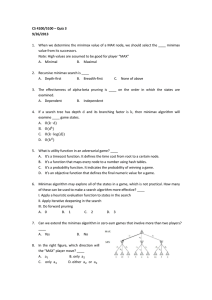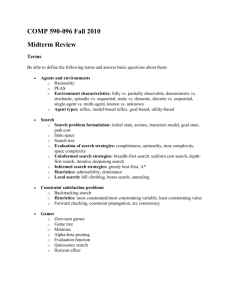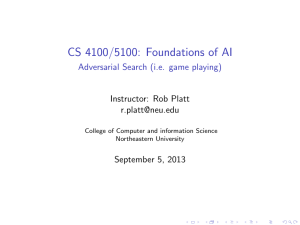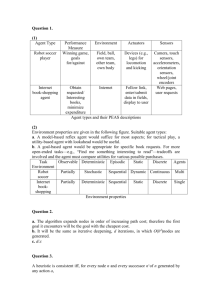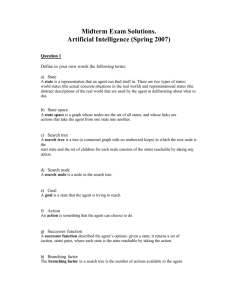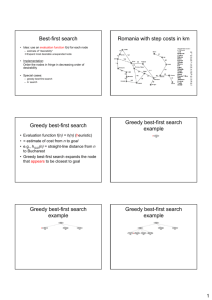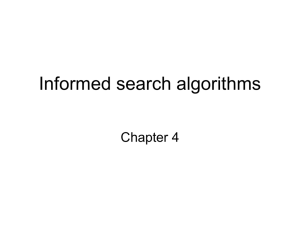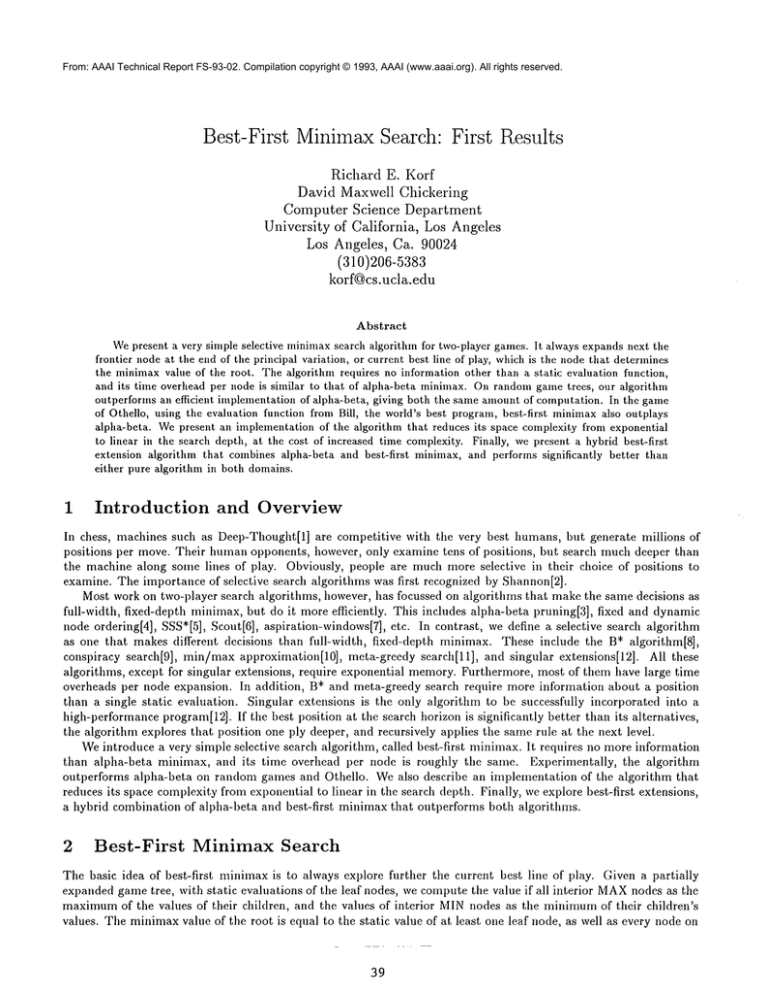
From: AAAI Technical Report FS-93-02. Compilation copyright © 1993, AAAI (www.aaai.org). All rights reserved.
Best-First MinimaxSearch: First Results
Richard E. Korf
David Maxwell Chickering
Computer Science Department
University of California, Los Angeles
Los Angeles, Ca. 90024
(310)206-5383
korf@cs.ucla.edu
Abstract
Wepresent a very simple selective minimaxsearch algorithm for two-player gaines. It ahvays expands next the
frontier node at the end of the principal variation, or current best line of play, which is the node that determines
the minimax value of the root. The algorithm requires no information other than a static evaluation function,
and its time overhead per node is similar to that of alpha-beta minimax. On random game trees, our algorithm
outperforms an efficient implementation of alpha-beta, giving both the same amount of computation. In the game
of Othello, using the evaluation function from Bill, the world’s best program, best-first minimax also outplays
alpha-beta. We present an implementation of the algorithm that reduces its space complexity from exponential
to linear in the search depth, at the cost of increased time complexity. Finally, we present a hybrid best-first
extension algorithin that combines alpha-beta and best-first
minimax, and performs significantly
better than
either pure algorithm in both domains.
1
Introduction
and Overview
In chess, machines such as Deep-Thought[l] are competitive
with the very best humans, but generate millions of
positions per move. Their human opponents, however, only examine tens of positions,
but search much deeper than
the machine along some lines of play. Obviously, people are much more selective
in their choice of positions to
examine. The importance of selective
search algorithms was first recognized by Shannon[2].
Most work on two-player search algorithms, however, has focussed on algorithms that make the same decisions as
full-width,
fixed-depth minimax, but do it more efficiently.
This includes alpha-beta pruning[3], fixed and dynamic
node ordering[4],
SSS*[5], Scout[6], aspiration-windows[7],
etc. In contrast, we define a selective search algorithm
as one that makes different
decisions
than full-width,
fxed-depth minimax. These include the B* algorithm[8],
conspiracy search[9],
rain/max approximation[10],
meta-greedy search[Ill,
and singular extensions[12].
All these
algorithms, except for singular extensions, require exponential memory. Furthermore, most of them have large time
overheads per node expansion. In addition,
B* and meta-greedy search require more information
about a position
than a single static evaluation.
Singular extensions is the only algorithm to be successfully
incorporated into a
high-performance program[12]. If the best position at the search horizon is significantly
better than its alternatives,
the algorithm explores that position one ply deeper, and recursively applies the same rule at the next level.
We introduce a very simple selective search algorithm, called best-first
minimax. It requires no more information
than alpha-beta
minimax, and its time overhead per node is roughly the same. Experimentally,
the algorithm
outperforms alpha-beta
on random games and Othello. ~¥e also describe an implementation of the algorithm that
reduces its space complexity from exponential to linear in the search depth. Finally, we explore best-first
extensions,
a hybrid combination of alpha-beta and best-first
miniinax that outperforms both algorithms.
2
Best-First
Minimax Search
The basic idea of best-first
minimax is to always explore fllrther
the current best line of play. Given a partially
expanded game tree, with static evaluations of the leaf nodes, we compute the value if all interior MAXnodes as the
maximumof the values of their children, and the values of interior
MIN nodes as the minimum of their children’s
values. The minimax value of the root is equal to the static value of at least one leaf node, as well as every node on
39
From: AAAI Technical Report FS-93-02. Compilation copyright © 1993, AAAI (www.aaai.org). All rights reserved.
the path to that leaf node. This path is called tile principal variation, and we call its leaf node the principal leaf.
Best-first minimaxalways expands next the current principal leaf. The primary motivation behind this algorithm is
that the principal leaf has the largest affect on the minimaxvalue of the root, although not necessarily the largest
affect on the movedecision to be made.
Consider the example ill figure 1, where squares represent MAX
nodes and circles represent MINnodes. Figure
1A shows the situation after tile root node has been expanded. The values of the children are their static evaluations,
and tile value of tile root is 6, the maximum
of its children’s values. This means that the right child is the principal
leaf, and is expandednext, resulting in the situation in figure lB. The new frontier nodes are statically evaluated at
5 and 2, and hence the value of their MINparent changes to 2, the minimumof its children’s values. This changes
the value of the root to 4, the value of its left child. Thus, the left movenowappears more promising, the left child
of tile root is the new principal leaf, and is expandednext, resulting in the situation in figure 1C. The value of the
left child of the root changes to the minimumof its children’s static values, 1, and the value of tile root changes to
the maximumof its children’s values, 2. At this point, attention shifts back to the right move, and the rightmost
grandchild of the root is expanded next, as shownin figure 1D.
A
B
C
D
53
Figure 1: Best-first
minimax search example
Best-first minimaxalways expands next the principal leaf. While this mayappear to lead to the exploration of a
single path to tile exclusion of all others, this does not occur in practice. The expansion of any node tends to makeit
look worse, thus inhibiting further exploration of the subtree below the node. For example, a MAX
leaf node will only
be expanded if its static value is the minimmnamongthe children of its MINparent. Expanding it changes its value
to the maxiinumvalue of its children, which tends to increase its value, making it unlikely to remain as the minimum
among its brothers. Similarly, MINnodes also tend to appear worse to their MAX
parents when expanded, making
it less likely that their children will be expandednext. Thus, this tempo effect adds balance to the tree searched by
best-first minimax.This effect tends to increase with increasing branching factor. Interestingly, while this oscillation
in values with the last player to moveis one reason that alpha-beta avoids comparingevahlations at different levels
in the tree, it turns out to be advantageous to best-first minimax.
While in principle best-first minimaxcould make a moveat any point in time, we choose to movewhen the length
of the t)rincipal variation exceeds a given depth bound, or a winning terminal node is chosen for expansion. This
ensures that the chosen movehas either been explored to a significant del)th, or leads to a win.
The obvious implementation of best-first miniinax maintains the entire current search tree in memory.Whena
node is expanded, its children are evaluated, its value is updated, and the algorithm movesup the tree updating the
values of its ancestors, until it either reaches the root, or a node whose value doesn’t change. It then movesdown
the tree to a nlaximum-vahled child of a MAXnode, or a mininmm-valuedchild of a MINnode, until it reaches a
new frontier node to expand next. The most significant drawback of this implementation is that it requires memory
that is exponential in the tree depth.
In spite of its simplicity, we couldn’t find this algorithm in the literature. A related algorithm is AO*[13], a
best-first search of a single-agent AND-OR
tree. The main difference is that in an AND-OR
tree, the cost of a node
is either the minimumof its children’s values (OR node), or the sum of its child values (ANDnode), as opposed
to the alternating minimizing and maximizing levels of a game tree. The closest algorithm to best-first minimax is
4O
From: AAAI Technical Report FS-93-02. Compilation copyright © 1993, AAAI (www.aaai.org). All rights reserved.
Rivest’s rain/max approximation[10]. Both algorithms strive to expand next the node with the largest affect on the
root value. The main difference is that best-first minimax is much simpler than min/max approximation. Note that
both AO*and min/max approximation also require exponential memory.
3
Recursive
Best-First
Minimax Search
Recursive Best-First MinimaxSearch (RBFMS)is an implementation of best-first minimax that runs in space linear
in the maximumsearch depth. The algorithm is a generalization of Simple Recursive Best-First Search(SRBFS)[14],
a linear-space best-first search designed for single-agent problems. Figure 2 shows the behavior of RBFMS
on the
exampleof figure 1.
Associated with each node on the principal variation is a lower bound Alpha, and an upper bound Beta, similar
to tlle corresponding bounds in alpha-beta minimax. A given node will remain on the principal variation as long as
its backed-up minimax value remains within these bounds. The root is bounded by -co and oo, since it is always
on the principal variation. Figure 2A shows the situation after the root is expanded, with the right child on the
principal variation. It will remain on the principal variation as long as its minimaxvalue is greater than or equal to
the maximum
value of its brothers (4). The right child is expanded next, resulting in the situation in figure 2B.
A
E
F
G
H
~_<~_<¢~
_<~
_<~
<5
<5
Figure 2: Recursive best-first
minimax search example
At this point, the value of the right child becomestile minimumof the values of its children (5 and 2), and since
2 is less than the lower boundof 4, the right child of the root is no longer on the principal variation, and the left
child is tlle new principal leaf. The algorithm returns to the root, freeing memory,but stores with the right child its
new minimaxvalue of 2, resulting in tile situation in figure 2C.
Tile left child of the root will nowremain on the principal variation as long as its value is greater than or equal
to 2, the largest value amongits brothers. It is expanded, resulting in the situation in figure 2D. Its new value is the
minimumof its children’s values (8 and 1), and since 1 is less than the lower bound of 2, tlle left child is no longer
41
From: AAAI Technical Report FS-93-02. Compilation copyright © 1993, AAAI (www.aaai.org). All rights reserved.
on the principal variation,
and the right child of the root becomes the new principal leaf. The algorithm returns to
the root, and stores the new minimax value of 1 with the left child, resulting in the situation in figure 2E. Now, the
right child of the root will remain on the principal variation as long as its minimax value is greater than or equal to
1, the value of its best brother, and is expanded next. The reader is encouraged to follow the rest of the example.
Tile values of interior nodes on the principal variation are not computed until necessary.
RBFMSconsists
of two recursive,
symmetric functions,
one for MAXand one for MIN. Each takes three arguments: a node, a lower bound Alpha, and an upper bound Beta. Together they perform a best-first
minimax
search of the subtree below the node, as long as its backed-up minimax value remains within the Alpha and Beta
bounds. Once it exceeds those bounds, the function returns the new minimax value of the node. At any point, the
recursion stack contains tile current principal variation, plus the immediate brothers of all nodes on this path. Its
space complexity is thus O(bd), where b is the maximumbranching factor of the tree, and d is the maximumdepth.
BFMAX (Node, Alpha, Beta)
FOR each Child[i] of Node
M[i] := Evaluation(Child[i])
IF M[i] > Beta return M[i]
sort Child[i] and M[i] in decreasing order of M[i]
IF only one child, M[2] := -infinity
WHILE Alpha <= M[I] <= Beta
MIll := BFMIN(Child[I], max(Alpha, M[2]), Beta)
insert Child[l] and M[I] in sorted order
return M[I]
BFMIN (Node, Alpha, Beta)
FOR each Child[i] of Node
M[i] := Evaluation(Child[i])
IF M[i] < Alpha return M[i]
sort Child[i] and M[i] in increasing order of M[i]
IF only one child, M[2] := infinity
WHILE Alpha <= M[I] <= Beta
MIll := BFMAX(Child[I], Alpha, min(Beta, M[2]))
insert Child[l] and M[I] in sorted order
return M[I]
When a node is expanded, its children are generated and evaluated one at a time. If the value of any child of a
MAXnode exceeds the upper bound of Beta, the child’s value is immediately returned,
and the remaining children
are not generated. Similarly, if the value of any child of a MINnode is less than the lower bound of Alpha, the child’s
value is returned without generating the remaining children.
For single-agent
problems, there are two linear-space
best-first
search algorithms, Simple Recursive Best-First
Search (SRBFS), and the much more efficient
Recursive Best-First
Search (RBFS). Surprisingly,
the two-player
generalizations
of these two algorithms behave identically,
so we present only the simpler version.
Syntactically,
recursive best-first
minimax appears very similar to alpha-beta minimax, but behaves quite differently. In particular, alpha-beta makes its move decisions solely on the basis of the static values of nodes at the search
horizon, whereas best-first
minimax relies on the values of nodes at different levels in the tree.
4
Saving the Tree
The cost of reducing the space complexity of best-first
minimax search from exponential to linear is that some nodes
are regenerated multiple times. This overhead is significant
for deep searches. On the other hand, the time per node
generation for RBFMSis significantly
less than that of standard best-first
search. In the standard implementation,
when a new node is generated, the entire board position of its parent node is copied, along with the changes made
to it. The recursive algorithm, however, does not copy the board, but only makes incremental changes to a single
copy, and undoes them when backtracking.
Our actual implementation retains the recursive control structure of R.BFMS, with only incremental changes to a
single copy of the board. When backing up the tree, however, the subtree is retained in memory. Thus, when a path
is abandoned and then reexplored, the entire subtree need not be regenerated, but only the nodes on the path to the
42
From: AAAI Technical Report FS-93-02. Compilation copyright © 1993, AAAI (www.aaai.org). All rights reserved.
new principal leaf, eliminating most node regenerations and all node reevaluations. While this requires exponential
space, it is not a problem in practice, for several reasons.
The main reason is that once a moveis made, and the opponent moves, best-first minimaxsaves only the suhtree
that is still relevant, pruning the subtrees below all moves it didn’t choose, and those moves not chosen by the
opponent. This releases the corresponding memory,and the search for the next movethen starts from the remaining
subtree. While current machines can fill their memories in a matter of minutes, in a two-player game, moves must
be made every few minutes, freeing much of the memory.
A second reason that memoryis not a serious constraint is that all that needs to be stored at a node is the backedup minimaxvalue of the node, and pointers to its children. The actual board itself, and all other information, is
incrementally generated from its parent. A node in our implementation only requires three words of memory, an
integer and two pointers. This could be reduced to two words by representing a leaf node as just an integer.
If memoryis exhausted in the course of computing a move, there are two options. One is to switch to the linearspace algorithm, thus requiring no more xnemory than the recursion stack. The other is to prune the least promising
parts of the current tree in memory.Since all nodes off the principal variation have their backed-up minimaxvalues
stored at all times, pruning is simply a matter of recursively freeing the memoryin a given subtree.
Since best-first minimaxspends most of its effort on the expected line of play, it can save muchof the information
collected for one move, and apply it to subsequent moves, particularly if the opponent makes the expected move.
This saving of tile tree between moves improves tile performance of best-first minimaxconsiderably. In contrast,
tile standard depth-first implementation of alpha-beta minimax doesn’t save any of the tree from one move to the
next. It essentially computes each new move from scratch. Even when alpha-beta is modified to save the relevant
subtree from one moveto the next, since it searches every moveto the same depth, relatively little of the subtree
computedduring one moveis still relevant after the player’s moveand the opponent’s response. In particular, it can
be shown that even in the best case, when the minimal tree is searched and the opponent makes the expected move,
only lib of the tree that is generated by alpha-beta in makingone movewill still be relevant after the moveand the
opponent’s move, where b is the branching factor of the tree.
5
Experimental
Results
The test of a selective search algorithm is howwell it plays. Weplayed best-first minimaxagainst alpha-beta minimax,
both in Othello[16, 17] and on random game trees[18], giving both algorithms the same amount of computation.
In a uniform random game tree with branching factor b and depth d, each edge is independently assigned a
random cost. The static value of a node is the sum of the edge costs from the root to the node. In order not to
favor MAXor MIN, the edge-cost distribution is symmetric around zero. Figure 3 shows a sample uniform binary
random game tree with edge costs chosen from -9 to 9. Since real games do not have uniform branching factors, in
our random gaines the number of children of a given node is a random variable uniformly distributed between one
and the maximumbranching factor B. Our edge-cost distribution is uniform from -215 to 215.
Figure 3: Saml)le uniform random game tree with b=2, d=3, and edge costs from [-9,9]
In generating a particular random tree, it is important that the same cost always be assigned to the same edge
of the tree. The simplest way to do this is to assign a unique integer to each edge of the tree, and to use that
integer as tim seed for the randoln number generator at that point[8]. Unfortunately, this produces more highly
43
From: AAAI Technical Report FS-93-02. Compilation copyright © 1993, AAAI (www.aaai.org). All rights reserved.
AB depth
I
2
3
4
g
8
BF depth
BF wins
I
50Z
4
66Z
8
73Z
12
72Z
15
57Z
19
61~
Table 1: Winning percentage of pure best-first
minimax vs. alpha-beta on Othello
correlated values than assigning successive random numbers to the tree edges in a breadth-first fashion, the scheme
we use. Doing this efficiently, however, requires a more complex calculation, which space restrictions prevent us from
detailing here.
One virtue of the random game tree is that it allows us to control the branching factor and depth of the game.
More importantly, however, the random game is simple enough to allow other researchers to reproduce our results.
Conversely, real game programs are complex, and good evaluation functions are hard to find. We obtained the
evaluation function for Bill[17], the world’s best Othello player, from Kai-Fu Lee, one of its authors.
The efficiency of alpha-beta is greatly affected by the order in which nodes are searched. The simplest way to
achieve good performance, called fixed ordering[4], is to fully expand each node, statically evaluate each child, sort
the children, and then search the children of MAX
nodes in decreasing order of their vahles, and the children of MIN
nodes in increasing order. Weuse fixed ordering on newly generated nodes until alpha-beta reaches one level above
the search horizon. At that point, since there is no advantage to ordering the nodes on the horizon, the children
are evaluated one at a time, allowing additional pruning. To ensure a fair comparison to best-first minimax, our
alpha-beta implementation saves the relevant subtree from one moveto the next. This allows us to order previously
generated nodes by their backed-up values rather than their static values, further improving the node ordering and
performance of alpha-beta. In addition, the previously generated nodes need not be reevaluated.
Each game was played twice, with each algorithm alternately movingfirst, to eliminate the effect of a particular
initial state favoring the first or second player to move. An Othello game is won by the player with the most discs
when no further inoves are possible. A random game ends when a terminal position is reached, 100 moves in our
experiments, and returns the value of the final position. Given a pair of random games, and the corresponding
terminal values reached, the winner is the algorithm that played MAX
when the larger terminal value was obtained.
Each random game tournament consisted of 100 pairs of games, and each Othello tournament consisted of 244 pairs
of games. Different randomgames were generated from different random seeds, from 1 to 100, while different Othello
games were generated by making all possible first four moves, and starting the game with the fifth move. A small
number of both Othello and random games were tied, but these are ignored in the results presented below.
Whenthe alpha-beta search horizon is sufficient to reach the end of the game, both algorithms use alpha-beta to
complete the game, since alpha-beta is optimal then the static values are exact. In Othello, the disc differential is
used as the exact value in searching the endgame, while the sum of the edge values becomes the exact value at the
end of a random game.
Since best-first searches deeper than alpha-beta in the same amountof time, it reaches the end of the gamebefore
alpha-beta does. Since disc differentials are not comparable to the values returned by Bill’s evaluation function,
Othello endgame positions are evaluated at -co if MAX
has lost, co if MAX
has won, and -co + 1 in the case of a
tie. If the principal leaf node is a terminal node, and a won position for best-first, it stops searching and makes a
move. If alpha-beta then makes the expected response, the principal leaf won’t change, and best-first will make its
next movewithout fllrther search. Conversely, if the principal leaf is a lost or tied position, best-first will continue to
search until it finds a wonposition, or runs out of time. While this endgameplay is not ideal and could be improved,
it is the most faithful to the original algorithm.
For each alpha-beta horizon, we experimentally determined what depth limit caused best-first to take most nearly
the same amountof time as all)ha-beta. This is done by running a series of tournaments, and incrementing the search
horizon of the algorithm that took less time in the last tournament. Node evaluation is the dominant cost for both
algorithms in both games, and running time is roughly proportional to the number of node evaluations.
Table 1 shows the results of the Othello experiments. The top line shows the different alpha-beta search depths,
and the second line shows the best-first search depth that took most nearly the same amount of time as the corresponding alpha-beta depth. The third line shows the percentage of games that were won by best-first minimax,
exchlding tie games. Each data point is an average of 244 pair of games, or 488 total games.
Both algorithms are identical at depth one. At greater depths, best-first searches muchdeeper than alpha-beta,
and wins most of the time. The winning percentage increases to 73%, and then begins to drop off at greater depths.
Table 2 shows the corresponding results for random game trees of various random branching factors. The branch-
44
From: AAAI Technical Report FS-93-02. Compilation copyright © 1993, AAAI (www.aaai.org). All rights reserved.
AB depth
i
2
3
4
~
6
7
8
9
B=2, BF depth
B=2, BF wins
1
50~
3
59~
6
74X
9
80~
13
76~
17
85~
22
83~
26
76X
33
82~
38
80X
B=3, BF depth
B=3, BF wins
I
50Z
3
65Z
7
89Z
I0
88Z
14
80Z
19
88Z
26
84Z
33
76Z
42
77Z
52
65Z
B=4, BF depth
B=4, BF wins
1
50Z
3
68Z
7
91Z
11
85Z
16
85Z
21
86Z
30
81Z
38
63Z
51
70Z
64
54Z
B=5, BF depth
B=5, BF wins
I
50Z
3
66Z
7
92Z
11
92Z
17
83Z
23
81Z
33
81Z
43
65Z
59
45~
76
40Z
B=IO, BF depth
B=IO, BF wins
1
50~
3
65~
8
97~
13
80~
22
76~
31
60~
48
46~
B=20, BF depth
B=20, BF wins
1
50~
3
66~
9
97~
16
86~
28
54~
Table 2: Winning percentage
of pure best-first
minimax vs. alpha-beta
lO
on random games
ing factor of an individual node is a random variable uniformly distributed from one to B, for all average branching
factor of (B+l)/2. Each data point is tile average of 100 pairs of games, or 200 total games.
Again, we see that best-first
significantly
outperforms alpha-beta, up to a point. The performance of best-first
search tends to degrade when the gap between the alpha-beta and best-first
horizons becomes very large, and in
some cases alpha-beta outperforms best-first
search. Note that the entire game is only 100 moves long.
6
Best-First
Extension:
A Hybrid Alpha-Beta/Best-First
Algorithm
In both the Othello and random game experiments, tile relative
performance of best-first
minimax degrades when
the difference
between the alpha-beta and best-first
search horizons becomes excessive. One explanation is that
while best-first
minimax evaluates every child of the root, it may not generate some grandchildren of the root at all,
depending on the static values of the children. In particular,
if the evaluation function grossly underestimates the
value of a child of tim root from the perspective of tile parent, it may never be expanded. For example, this would
occur in a piece trade whose first move is a sacrifice.
At some point, it makes more sense to consider grandchildren
of the root instead of a node 30 or more moves down the principal variation.
To correct this, we implemented a hybrid algorithm, called best-first
extension, that combines the coverage of
alpha-beta with the penetration of best-first
minimax. Best-first
extension performs alpha-beta to a shallow search
horizon, and then executes best-first
search to a much greater depth, starting with the tree, backed-up values, and
principal
variation
generated by the alpha-beta
search. This guarantees that every move wilt be explored to a
minimumdepth, regardless of its static evaluation, before exploring the most promising moves much deeper. Tiffs is
similar to the approach taken by singular extension search[12].
Best-first
extension has two parameters: the depth of the initial alpha-beta search, and the depth of the following
best-first
scarch. In our initial experiments, the alpha-beta horizon of the initial search was set to one less than the
horizon of its pure alpha-beta opponent, and the best-first
horizon is whatever depth takes the same total amount
of time, including the alpha-beta search, as the pure alpha-beta opponent. Even in this case, most of the time is
spent on the best-first
extension. Table 3 shows the results for Othello, in the same format as table 1, and Table
4 shows the results for the random game trees. Against alpha-beta depths 1 and 2, best-first
extension is identical
to pure best-first
minimax, since it always evaluates all nodes at depth 1. At greater depths, however, the results
for best-first
extension are significantly
better than for pure best-first
minimax. In both games, best-first
extension
outperforms alpha-beta
in every tournament.
45
From: AAAI Technical Report FS-93-02. Compilation copyright © 1993, AAAI (www.aaai.org). All rights reserved.
AB depth
1
2
3
BF depth
BF wins
1
50%
4
66%
7
83%
Table 3: Winning percentage
AB depth
of best-first
4
I0
79%
extension
g
6
7
14
64%
18
72%
21
69%
vs. alpha-beta
on Othello
1
2
3
4
5
6
7
8
9
10
B=2, BF depth
B=2, BF wins
1
50%
3
59%
6
68%
7
81%
10
75%
12
82%
15
79%
17
78%
21
80%
24
78%
B=3, BF depth
B=3, BF wins
1
50%
3
65%
6
91%
8
86%
11
85%
14
78%
19
90%
22
82%
29
88%
35
81%
B=4, BF depth
B=4, BF wins
1
50~
3
68~
7
98~
9
88~
12
90~
16
91~
23
84~
27
81~
38
87~
45
84~
B=5, BF depth
B=5, BF wins
1
50Z
3
66Z
7
95%
9
89%
14
89%
18
89%
26
83%
32
85Z
46
87%
56
75%
B=IO, BF depth
B=IO, BF wins
I
50Z
3
65Z
8
99Z
II
95~
19
92Z
25
84Z
41
82Z
B=20, BF depth
B=20, BF wins
1
50%
3
66%
9
98%
13
95%
25
88~
Table 4: Winning perceutage
7
Conclusions
of best-first
and Further
extension
vs. alpha-beta
on random games
Work
We presented a very simple selective search algorithm, best-first
minimax. It always expands next the frontier node
at the end of the current principal variation,
which is the node that determines the minimax value of the root.
An important advantage of the algorithm is that it can save most of the results
from one move computation, and
apply them to subsequent moves. In experiments
on random games and on Othello,
best-first
minimax outplays
all)ha-beta,
giving both algorithms the same amount of computation, up to a given search depth. We also presented
a hybrid combination of best-first
minimax and alpha-beta,
which guarantees that every move is searched to a
mininmm depth. This best-first
extension outperforms both algorithms in both games, defeating alpha-beta in every
tournament. While memory capacity was not a limiting factor in our experiments,
we also showed how to reduce
the space complexity of the algorithm from exponential to linear in the search depth, but at significant cost in nodes
generated for deep searches.
Since pure best-first
minimax performs best against relatively shallow alpha-beta searches, it is likely to be most
valuable in games with large branching factors,
and/or expensive evaluation functions.
These are the games, such
as Go, in which computers have been least successful against humans. Current research is focussed on implementing
singular extensions in an attempt to improve our alpha-beta opponent, and implementations on other games such as
chess.
8
Acknowledgements
Thanks to Kai-Fu Lee for providing the sources to Bill, to Stuart Russell for providing an initial
Othello evaluation
function, to Milos Ercegovac and Peter Montgomery for technical assistance in efficiently
generating random trees,
to Joe Pemberton and Weixiong Zhang for discussions
concerning tiffs research,
and to Valerie Aylett for drawing
the figures.
This research was supported by NSF Grant No. IRI-9119825, and a grant from Rockwell International.
46
From: AAAI Technical Report FS-93-02. Compilation copyright © 1993, AAAI (www.aaai.org). All rights reserved.
References
[1] Hsu, F.-H., T. Anantharaman, M. Campbell, and A. Nowatzyk, A grandmaster chess machine, Scientific
ican, Vol. 263, No. 4, Oct. 1990, pp. 44-50.
Amer-
[2] Shannon, C.E., Programminga computer for playing chess, Philosophical Magazine, Vol. 41, 1950, pp. 256-275.
[3] Knuth, D.E., and R.E. Moore, An analysis of Alpha-Beta pruning, Artificial
pp. 293-326.
Intelligence,
[4] Slagle, J.R., and Dixon, J.K., Experiments with some programs that search game trees,
2, 1969, pp. 189-207.
[5] Stockman, G., A minimax algorithm better than Alpha-Beta? Artificial
179-96.
Intelligence,
Vol. 6, No. 4, 1975,
J.A.C.M., Vol. 16, No.
Vol. 12, No. 2, 1979, pp.
[6] Pearl, J. Heuristics, Addison-Wesley,Reading, Mass, 1984.
[7] Kaindl, H., R. Shams, and H. Horacek, Minimax search algorithms with and without aspiration windows, IEEE
Transactions on Pattern Analysis and Machine Intelligence, Vol. 13, No. 12 December1991, pp. 1225-1235.
[8] Berliner, H.J., The B* tree search algorithm: a best-first
pp. 23-40.
proof procedure, Artificial
[9] McAllester, D.A., Conspiracy numbers for min-max search, Artificial
287-310.
Intelligence,
[10] Rivest, I~.L., Gametree searching by rain/max approximation, Artificial
77-96.
Intelligence, Vol. 12, 1979,
Vol. 35, No. 3, 1988, pp.
Intelligence,
Vol. 34, No. 1, 1986, pp.
[11] l~ussell, S., and E. Wefald, On optimal game-tree search using rational meta-reasoning, Proceedings of the
Eleventh International Conference on Artificial Intelligence (IJCAI-89), Detroit, Michigan, August 1989, pp.
334-340.
[12] Anantharaman, T., M.S. Campbell, and F.-H. Hsu, Singular extensions: Adding selectivity
ing, Artificial Intelligence, Vol. 43, No. 1, April, 1990, pp. 99-109.
[13] Nilsson, N.J., Problem-Solving Methods in Artificial
[14] Korf, R.E., Linear-space best-first
Iutelligence,
to brute-force search-
McGraw-Hill,NewYork, 1971.
search, Artificial Intelligence, Vol. 62, No. l, July 1993, pp. 41-78.
[15] Korf, R.E., Best-first minimax search: Initial results, Computer Science Department Technical Report, No.
CSD-920021,University of California, Los Angeles, Ca. 90024, January, 1992.
[16] Rosenbloom,P.S., A world-championslfip-level Othello program, Artificial
320.
Intelligence,
[17] Lee, K.-F. and S. Mahajan, The developinent of a world-class Othello program, Artificial
No. 1, 1990, pp. 21-36.
Vol. 19, 1982, pp. 279hdelligence, Vol 43,
[18] Fuller, S.H., J.G. Gaschnig, and J.J. Gillogly, An analysis of the all)ha-beta 1)runing algorithm, Dept. of Computer Science Technical Report, Carnegie-Mellon University, Pittsburgh, Pa., 1973.
47

